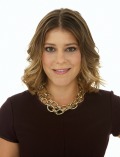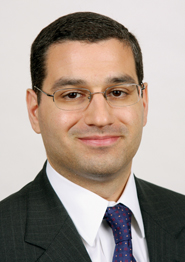Rising Stars
Recognizing todays and tomorrows leaders, the Rising Star Award is intended for high-impact professionals who will continue to lead the industry for years to come.
Clare Fraser, managing director, strategy, Omgeo
Dont judge a book by its cover-or an opportunity by its location. Even if it requires traveling halfway around the world.
Clare Fraser, managing director of strategy at Omgeo, began her career in her native Australia back in 1996. Little did she know that it would take her from the land down under to Hong Kong, and then to Belgium and later London. And again back to Hong Kong. As she puts it, her passport is well worn and she is never in need of frequent flier miles.

For her, travel and international exposure are the cost of doing business and ascending the financial services ladder. But that cost, jet lag, time away from family and other challenges are well worth it.
[See All The 2013 Wall Street Women Winners]
I really dont think there is a cost when you look at the benefits of working for an international firm, Fraser said. You just cant underestimate the value of working internationally. I strongly believe that for every role Ive had, theres a bonus that offsets any personal cost.
In her 17 years in finance, Fraser added, she has always looked at opportunities deeply and not taken them at face value. I never say no to an opportunity, even if the benefit is not readily seen. Adaptability is her middle name. She estimates that she has lived in 10 cities in the last 15 years.
If you want to be relevant in this business, you have to keep an open mind, especially when it comes to your career trajectory, she said.
And for Fraser that flight plan rivals any transcontinental flight. She began her career in in her native Australia at Macquarie back in 1996, joining the firms graduate training program and landing a position in strategy for the chief executive officer.
She left Macquarie in 1999 and moved to Hong Kong, looking to broaden her knowledge of Asia and finance, and landed at Credit Suisse First Boston. At the investment bank she switched gears and worked in mergers and acquisitions in the firms financial institutions group during the dot-com boom, seeing it from an Eastern perspective rather than U.S.-centric one. She stayed there for three years and in 2001 packed her bags again. This time, she was headed for Europe.
Armed with a thorough knowledge of the Asian and Australian markets, she landed in Brussels, Belgium, and went to work for the European Commission as a consultant. Working in the research directorate general, she found herself leading the strategic assessment of financial control instruments and increasing her knowledge about regulation and its role in the capital markets.
This exposure really helped me understand how things are done in different cultures, she said.
During her downtime away from the commission, Fraser relaunched her career and got an MBA. While studying, she was exposed to 36 different cultures, absorbing their idiosyncrasies to better understand business on a global scale.
Her studies completed, she joined HSBC Securities Services unit and eventually rose to become its global head of strategy, focusing on Europe. She split her five years at the Asia-based bank between London and Hong Kong until leaving in 2011.
Armed with a global education and international pedigree, she joined Omgeo, a firm that delivers post-trade and settlement solutions to global clients. The Depository Trust & Clearing Corp. completed its acquisition of Omgeo in October. Fraser relishes her new role amid the constant technological change in the financial markets. After all, she is a student of change and adaptability.
You have to be adaptable in this environment or any, if you want to be relevant, Fraser said. Never look at an opportunity at face value, and never say no to an opportunity without learning the facts, even if you cant see its immediate value.









Increasing Volume & Opportunities
The global FX market, the world’s largest and most liquid asset class, continues to grow and evolve. It has bucked the trend in volume declines over the past two years that were seen in other asset classes such as stocks and bonds – even with a bottoming in its own trading activity in Q3 2012, it has staged a strong comeback ever since.
Global FX trading volume has seen tremendous growth over the last decade. The most recent BIS figure indicates global FX volume of $5.3 trillion in average daily trade volume, representing a vibrant market compared with other asset classes. Electronic trading has become the main mode of trading in FX and now accounts for more than 60 percent of all trading done in the global FX market. Moreover, Aite Group expects to see electronic trading adoption to continue in the FX market, reaching 70 percent by the end of 2013.
Over the last 12 to 18 months, the FX market has seen emergence of new FX trading venues that are attempting to take away market share away from incumbent players. There are numerous reasons for the entrance of new FX venues. Some of these reasons include:
Traditional electronic venues such as EBS and Reuters have been gradually losing market share to HFT-oriented market-making or proprietary trading firms, providing much-needed hope for new entrants to build attractive levels of liquidity unthinkable even three years ago.
Dealing banks have become increasingly dissatisfied with the current group of FX venues due to (1) what they perceive as certain practices that favor automated trading firms and (2) the outdated trading infrastructures of existing platforms. Both of these may lead to potential opportunities for new venues.
New participants from non-FX markets have entered the space looking for faster, more transparent FX trading venues similar to what they are used to in equities and futures markets.
Continuing regulatory changes in the OTC derivatives markets across different asset classes such as fixed income, commodities, and equities are leading to growing expectations from global FX market participants that similar obligations will be eventually applied to the FX market.
The existence of an FX ecosystem has drastically lowered the cost of entry for new market players.
There are many new emerging trends that will impact the health and dynamics of the global FX market in 2013 and beyond. First, as the FX market has gone more mainstream and FX has become accepted as a legitimate asset class, a genuine, industry-initiated effort seeks to introduce enhanced transparency into the market and provide a fair trading environment for both institutional and retail clients alike.
Second, fueled by these industry-led initiatives, the next phase of competition in electronic FX trading market has begun. Over the last 18 months, new FX venues have emerged at a rapid pace often touting increased transparency, low latency, and cost-effective trading as key characteristics of their competitive offerings.
Third, banks rely increasingly on internalization of client order flow to manage their market risk.
Fourth, thanks to new technological innovations as well as by market structural changes as a result of new demand-supply dynamics and new regulations, there are more choices than ever in electronic trading venues. Customers can choose to trade electronically via RFQ/RFS in single or multi-bank platforms, ECNs with streaming quotes and central limit order books, or exchanges.
Fifth, key findings by FX regulatory bodies indicate that the average trade size of spot transactions has already dropped two- to threefold over the last three years, while the number of trades has gone up more than 50 percent during the same period. With expected continued growth in HFT volume and increasing market participation by retail traders, the average trade size of spot FX is expected to decrease even more in coming years.
Sang Lee is co-founder and managing partner of Aite Group. Follow him on Twitter at @aitegroup.
The views represented in this commentary are those of its author and do not reflect the opinion of Traders Magazine or its staff. Traders Magazine welcomes reader feedback on this column and on all issues relevant to the institutional trading community. Please send your comments to Traderseditorial@sourcemedia.com
(c) 2013 Traders Magazine and SourceMedia, Inc. All Rights Reserved.
http://www.tradersmagazine.com http://www.sourcemedia.com/